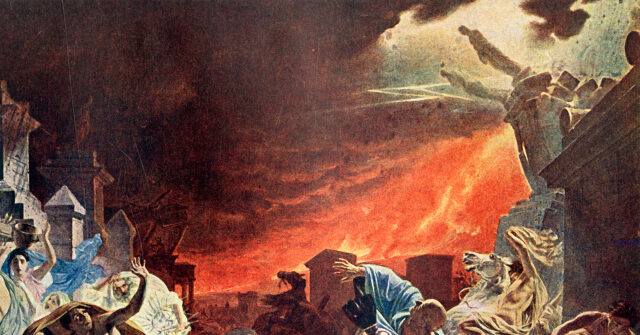Share this @internewscast.com
A recently unearthed artifact from an ancient Roman urban center provides fascinating insights into the everyday existence of people who lived two millennia ago.
The latest discovery involves a ceramic piece originating from Egypt, found at the historic site of Pompeii, famously devastated by a volcanic eruption in 79 AD, as reported by Art News on November 10.
A photo shows the ancient vase, which appears to be a greenish blue color:
According to officials, “This glazed vessel, typically seen as a sought-after garden or decorative item in the Vesuvian region, was repurposed here as a kitchen container,” shared by Fox News.
This significant find was detailed in the journal of the Pompeii Archaeological Park, as noted by Art News:
In 79 AD, Pompeii was enveloped in a thick layer of volcanic ash following the eruption of Mount Vesuvius, History.com recounts.
“A witness described the ash as it ‘poured across the land’ like a flood, cloaking the city in ‘a darkness…like the black of closed and unlighted rooms,'” the site reveals.
This particular thermopolium, which was fully excavated and restored in 2020, is particularly well preserved and notable for the painted depictions of birds and other animals that adorn its walls. The shop consisted of an L-shaped counter with large serving containers set into in its masonry top, a kitchen in the back stacked with vessels for storing provisions, and an upstairs apartment for the restaurant’s manager or owner. A bathroom was just inside the door.
Pompeii was buried under a thick carpet of volcanic ash in 79 AD when Mount Vesuvius erupted, according to History.com.
“The dust ‘poured across the land’ like a flood, one witness wrote, and shrouded the city in ‘a darkness…like the black of closed and unlighted rooms,’” the site said.
The city was abandoned after the eruption killed 2,000 people, but it was rediscovered in 1748 when explorers found the city was mostly intact underneath the dust.
“The buildings, artifacts and skeletons left behind in the entombed city have taught us a great deal about everyday life in the ancient world,” the History.com article noted.
An animation film shows what it may have looked like when the volcano erupted:
Officials did not reveal their find until recently even though the spot was excavated in 2023, according to Fox.
Park director Gabriel Zuchtriegel explained, “We see here a certain creativity in decorating both sacred and everyday spaces — that is, the household altar and the kitchen — using objects that reflect the permeability and mobility of tastes, styles and likely also religious ideas within the Roman Empire.”
He added, “And we see this phenomenon not at an elite level, but in the backroom of a popina, a street food outlet of Pompeii — in other words, at a middle- or lower-class level of local society, which nonetheless played a key role in promoting Eastern cultural and religious forms, including Egyptian cults and, later, Christianity.”

















